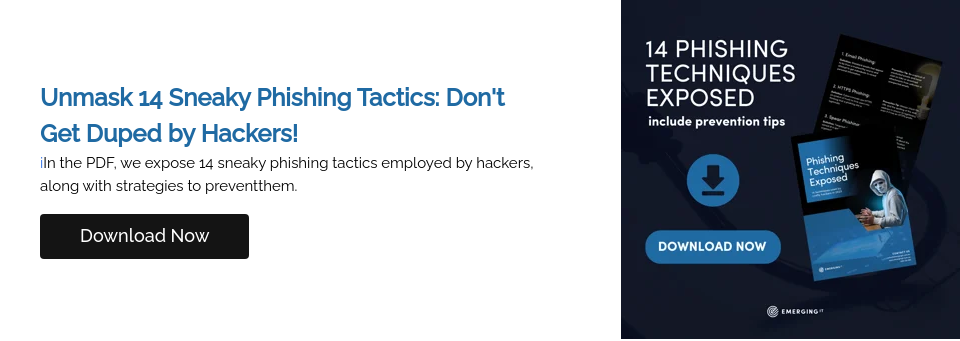Key Findings
- Phishing Effectiveness: Phishing remains prevalent, with over 90% of cyberattacks initiated through it, exploiting human psychology for deception.
- AI's Impact on Phishing: AI enhances phishing by creating engaging emails and deep fake content, using extensive data for tailored and convincing schemes.
- Empowering SMEs: AI-driven cybersecurity market value to exceed $46 billion by 2027, offering SMEs effective countermeasures against AI-driven attacks.
- Proactive Measures: Employ advanced email security, AI-enhanced training, and application whitelisting.
- Active Defense: Conduct threat hunting, regular security assessments, penetration testing, and vulnerability management.
- External Support: You can collaborate with external experts, like managed service providers, for real-time monitoring and incident response.
Battling the AI-Driven Wave of Phishing: Safeguarding SMEs Amidst Growing Threats
In an ever-evolving digital landscape, cybercriminals have discovered a powerful weapon in AI-powered tools to carry out their malicious intentions. The alarming rise in AI-driven phishing campaigns specifically targeting small and medium-sized enterprises (SMEs) is of particular concern. This article plunges deep into the sinister convergence of AI and the social engineering tactics employed by hackers, shedding light on the vulnerabilities they exploit. While the challenges may seem daunting, this piece also presents robust strategies SMEs can adopt to strengthen their defences and combat this growing threat.
The Irresistible Appeal of Phishing as a Weapon
Phishing, with its deceptive allure, remains the favoured weapon of hackers due to its effectiveness. Unlike traditional hacking methods that involve breaching complex security systems, phishing exploits human psychology and the willingness to disclose sensitive information. This approach has proven astonishingly successful, with over 90% of cyberattacks initiated through phishing.
AI's Unsettling Impact on Phishing
The emergence of AI technology has further amplified the threat landscape, particularly in phishing. Phishing emails driven by AI have proven more engaging than those crafted by humans, resulting in higher interaction rates. With AI's exceptional ability to analyse extensive amounts of public data, hackers are empowered to craft tailored schemes that convincingly deceive individual victims. Additionally, AI can generate deep fake content, such as realistic videos and audio recordings, which can trick victims into unknowingly divulging sensitive information or making unauthorised transactions.
Empowering SMEs Against AI-Powered Threats
AI not only empowers cybercriminals but also provides small and medium-sized enterprises (SMEs) with opportunities to counteract the threats they face. By embracing AI-driven cybersecurity, SMEs can effectively counteract the threats they face. The market value of AI-empowered cybersecurity is projected to surpass $46 billion by 2027, indicating a significant increase in defensive measures against AI-driven attacks.
Strategies to Stay One Step Ahead
- Advanced Anti-Virus Threat Hunting Software: Threat hunting is an active approach that tirelessly scans networks, systems, applications, or devices to uncover any signs of malicious activity. By combining manual and automated techniques, such as log analysis, network scans, and intelligence feeds, threat hunting identifies potential threats and strengthens your security compliance. With round-the-clock monitoring and included remediation, this invaluable service ensures your organisation stays one step ahead of cybercriminals.
- Advanced Email Security: To proactively shield their inboxes from malicious phishing emails, SMEs should prioritise investing in advanced email protection systems that offer robust anti-spam and anti-malware solutions.
- AI-Enhanced Social Engineering Simulations: Harnessing the power of AI in phishing and social engineering simulations empowers SMEs to educate their employees on recognising crucial signs of phishing attempts. This comprehensive training boosts the organisation's readiness and preparedness against cyber threats.
- Security Assessments: Performing regular and thorough security assessments, encompassing vulnerability scans, empowers SMEs to take proactive measures to identify and resolve potential vulnerabilities before cybercriminals can exploit them.
- Penetration Testing: Simulating real-world cyberattacks through regular Penetration Testing is crucial in identifying vulnerabilities within an organisation's systems, networks, and applications. By pinpointing weaknesses before malicious actors can exploit them, this proactive approach helps fortify the organisation's defences and ensures the safety of digital assets.
- Vulnerability Management Service (VMS): VMS, or Vulnerability Management Service, involves the continuous identification, evaluation, mitigation, and reporting of vulnerabilities within your environment.
- Multi-Factor Authentication (MFA): Implementing MFA for accessing critical systems and applications adds an extra layer of security by requiring additional verification beyond passwords.
- Application Whitelisting: Application whitelisting serves as a crucial cybersecurity measure that ensures only authorised and specified applications can operate within a system or network, significantly bolstering security by effectively blocking the execution of any unauthorised software.
- External Expertise: SMEs lacking in-house cybersecurity expertise can collaborate with managed service providers (MSPs) or external IT providers. These partners offer real-time threat monitoring, ongoing training, and incident response planning.
Conclusion
The rapid advancement of AI has provided cybercriminals with a formidable arsenal to execute highly sophisticated phishing attacks, posing a significant threat to SMEs. However, this same technology also offers SMEs robust defences to combat these malicious tactics. By embracing AI-driven cybersecurity strategies, small and medium-sized enterprises can level the playing field and protect their valuable digital assets. As the landscape of AI-powered phishing continues to evolve, SMEs must remain vigilant, prepared, and unwavering in their commitment to combat these insidious threats.
See our senior penetration tester demonstrate how hackers bypass MFA and access employee Microsoft 365 details.
Watch the video now